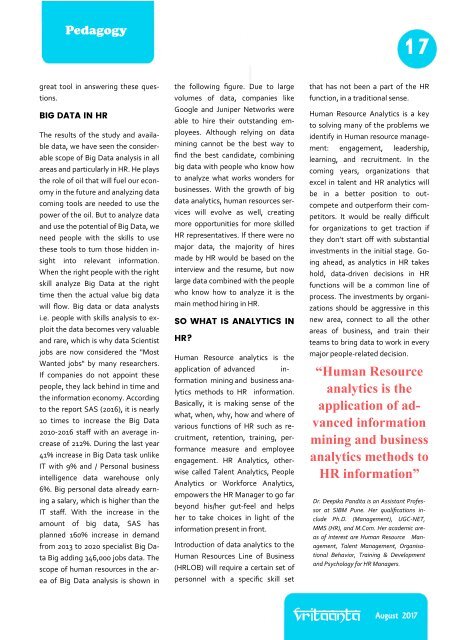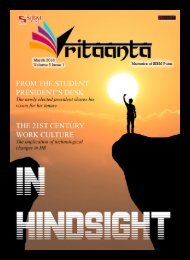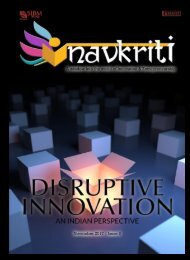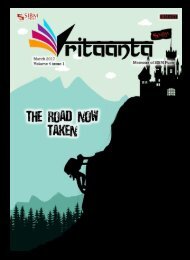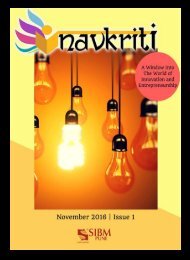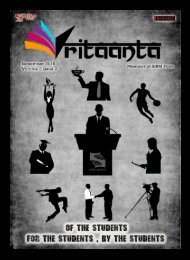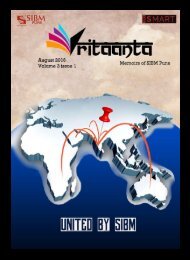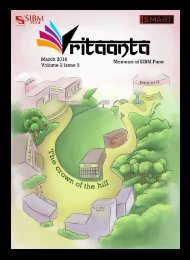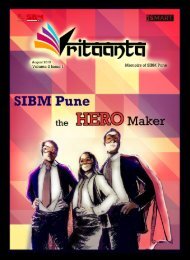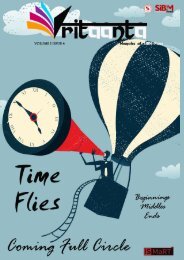Vritaanta Volume 4 Issue 2 August 2017
Pune was nicknamed “The Oxford of the East” by the Late Pandit Jawaharlal Nehru, who was impressed with the wide array of excellent educational institutes present in the city, and SIBM Pune remains a shining example of leading the way to maintain this sobriquet. SIBM Pune prides itself on being the hub of diversity, attracting students from various educational and professional backgrounds which lead to a diverse group - inviting ways of driving fresh thinking, new insights, and challenging perspectives. Apart from the corporate competitions; SIBM Pune had some innovative events and tournaments of our own. Explore more about Aarambh 2017 - a cultural event where student teams from SIBM Pune along with other sister institutes come together to showcase their talents. Colosseum, an inter batch competition with events like extempore, business quiz, group dances, music, and case studies while Hoopster and Dwandva catered to sports lovers.
Pune was nicknamed “The Oxford of the East” by the Late Pandit Jawaharlal Nehru, who was impressed with the wide array of excellent educational institutes present in the city, and SIBM Pune remains a shining example of leading the way to maintain this sobriquet. SIBM Pune prides itself on being the hub of diversity, attracting students from various educational and professional backgrounds which lead to a diverse group - inviting ways of driving fresh thinking, new insights, and challenging perspectives. Apart from the corporate competitions; SIBM Pune had some innovative events and tournaments of our own. Explore more about Aarambh 2017 - a cultural event where student teams from SIBM Pune along with other sister institutes come together to showcase their talents. Colosseum, an inter batch competition with events like extempore, business quiz, group dances, music, and case studies while Hoopster and Dwandva catered to sports lovers.
You also want an ePaper? Increase the reach of your titles
YUMPU automatically turns print PDFs into web optimized ePapers that Google loves.
Pedagogy<br />
17<br />
great tool in answering these questions.<br />
BIG DATA IN HR<br />
The results of the study and available<br />
data, we have seen the considerable<br />
scope of Big Data analysis in all<br />
areas and particularly in HR. He plays<br />
the role of oil that will fuel our economy<br />
in the future and analyzing data<br />
coming tools are needed to use the<br />
power of the oil. But to analyze data<br />
and use the potential of Big Data, we<br />
need people with the skills to use<br />
these tools to turn those hidden insight<br />
into relevant information.<br />
When the right people with the right<br />
skill analyze Big Data at the right<br />
time then the actual value big data<br />
will flow. Big data or data analysts<br />
i.e. people with skills analysis to exploit<br />
the data becomes very valuable<br />
and rare, which is why data Scientist<br />
jobs are now considered the "Most<br />
Wanted jobs" by many researchers.<br />
If companies do not appoint these<br />
people, they lack behind in time and<br />
the information economy. According<br />
to the report SAS (2016), it is nearly<br />
10 times to increase the Big Data<br />
2010-2016 staff with an average increase<br />
of 212%. During the last year<br />
41% increase in Big Data task unlike<br />
IT with 9% and / Personal business<br />
intelligence data warehouse only<br />
6%. Big personal data already earning<br />
a salary, which is higher than the<br />
IT staff. With the increase in the<br />
amount of big data, SAS has<br />
planned 160% increase in demand<br />
from 2013 to 2020 specialist Big Data<br />
Big adding 346,000 jobs data. The<br />
scope of human resources in the area<br />
of Big Data analysis is shown in<br />
the following figure. Due to large<br />
volumes of data, companies like<br />
Google and Juniper Networks were<br />
able to hire their outstanding employees.<br />
Although relying on data<br />
mining cannot be the best way to<br />
find the best candidate, combining<br />
big data with people who know how<br />
to analyze what works wonders for<br />
businesses. With the growth of big<br />
data analytics, human resources services<br />
will evolve as well, creating<br />
more opportunities for more skilled<br />
HR representatives. If there were no<br />
major data, the majority of hires<br />
made by HR would be based on the<br />
interview and the resume, but now<br />
large data combined with the people<br />
who know how to analyze it is the<br />
main method hiring in HR.<br />
SO WHAT IS ANALYTICS IN<br />
HR?<br />
Human Resource analytics is the<br />
application of advanced<br />
information<br />
mining and business analytics<br />
methods to HR information.<br />
Basically, it is making sense of the<br />
what, when, why, how and where of<br />
various functions of HR such as recruitment,<br />
retention, training, performance<br />
measure and employee<br />
engagement. HR Analytics, otherwise<br />
called Talent Analytics, People<br />
Analytics or Workforce Analytics,<br />
empowers the HR Manager to go far<br />
beyond his/her gut-feel and helps<br />
her to take choices in light of the<br />
information present in front.<br />
Introduction of data analytics to the<br />
Human Resources Line of Business<br />
(HRLOB) will require a certain set of<br />
personnel with a specific skill set<br />
that has not been a part of the HR<br />
function, in a traditional sense.<br />
Human Resource Analytics is a key<br />
to solving many of the problems we<br />
identify in Human resource management:<br />
engagement, leadership,<br />
learning, and recruitment. In the<br />
coming years, organizations that<br />
excel in talent and HR analytics will<br />
be in a better position to outcompete<br />
and outperform their competitors.<br />
It would be really difficult<br />
for organizations to get traction if<br />
they don’t start off with substantial<br />
investments in the initial stage. Going<br />
ahead, as analytics in HR takes<br />
hold, data-driven decisions in HR<br />
functions will be a common line of<br />
process. The investments by organizations<br />
should be aggressive in this<br />
new area, connect to all the other<br />
areas of business, and train their<br />
teams to bring data to work in every<br />
major people-related decision.<br />
“Human Resource<br />
analytics is the<br />
application of advanced<br />
information<br />
mining and business<br />
analytics methods to<br />
HR information”<br />
Dr. Deepika Pandita is an Assistant Professor<br />
at SIBM Pune. Her qualifications include<br />
Ph.D. (Management), UGC-NET,<br />
MMS (HR), and M.Com. Her academic areas<br />
of interest are Human Resource Management,<br />
Talent Management, Organisational<br />
Behavior, Training & Development<br />
and Psychology for HR Managers.<br />
VRITAANTA<br />
<strong>August</strong> <strong>2017</strong>


